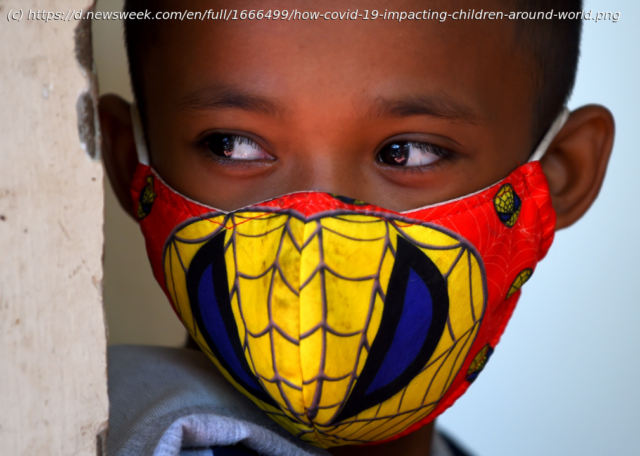Children around the world have been affected by COVID-19 in numerous ways from school to socializing to healthcare.
On Oct.1,2020, the New York City public school system became the first major city to reopen classrooms for in-person learning. Not only are school protocols and infrastructures being tested, but New York City’s rate of COVID-19-positive tests increased earlier in the week to a little over 3% before dropping. Mayor Bill de Blasio announced that schools would return to remote learning if the city’s seven-day rolling average stayed at 3%. Just a few days after reopening, on Oct.5, the city announced closures of schools in nine areas with case surges. Returning to school takes some of the burden off working parents and returns children to the structure and normalcy school provides, but it comes at the price of increased rates of COVID-19 among children and adolescents. In April, children accounted for 2.2% of COVID-19 cases across the U.S. At the end of September, children made up 10% of cases, according to the American Academy of Pediatrics. The rise is likely due to children returning to schools, playing sports, and hanging out with friends. Many schools are continuing virtual learning, forcing beleaguered parents to juggle work and childcare. Virtual learning exposes the technology gaps that have left students from vulnerable communities without essential tools needed to complete online lessons at home. Children are affected outside of schooling, too. Supply chain issues have created vaccine shortages in poor countries, leaving children at risk of dying from preventable diseases. Some children may also be at risk of homelessness and other dangers, as orphanages become short-staffed and foster families stop accepting new kids. Children also need to contend with the stress of living through a pandemic, which is affecting behaviors and making kids more irritable and fearful. To understand the many ways the coronavirus is affecting children around the world, Stacker took a look at scientific research, news articles, government reports, and information from nonprofit organizations. Read on to learn more about the impact of the novel coronavirus on children. You may also like: What are contact tracers? And how many each state needs to safely reopen The COVID-19 outbreak forced schools to close in 199 countries at the peak of closures in April 2020, according to the World Food Programme. As a result, at least 369 million children around the world missed out on meals at school. Despite attorneys’ requests to delay hearings during the pandemic, unaccompanied immigrant children threatened by deportation are going through the process of requesting asylum in the U.S. over video as part of a pilot program in Houston. Immigration attorneys have said that the pilot program lacks due process, according to Texas Monthly reporting in April 2020. The virtual asylum proceedings have also been riddled with technical difficulties. Long-term social distancing measures can damage children’s social development, according to Healthline. Psychologists say that virtual social interactions don’t offer the same level of intimacy as in-person connections for adolescents, which could “dramatically decrease their opportunities for new experiences and self-discovery.” Some high schools in the U.S. postponed graduation ceremonies for the class of 2020 while others cancelled them altogether. Students and their parents were “heartbroken” that their academic achievement may go unrecognized due to the coronavirus, according to USA Today reporting. After being forced to close due to the pandemic, many school districts have switched to online instruction. However, technology gaps and financial difficulties are leaving some students behind. According to The Philadelphia Inquirer, one teacher even reported that at least 25% of her students were failing to attend online lessons or complete homework because they lacked WiFi or had to spend time working or caring for relatives, soon after the switch to remote learning in April. You may also like: 50 indicators for understanding America’s economy right now More than 220 million children in China were forced to stay inside their homes in an effort to prevent the spread of COVID-19. The confinement poses potential risks to children’s physical and mental health, according to an article published in The Lancet journal. Stuck at home, children may be physically less active, have sleep disruptions, and eat less healthy food, warn researchers. Amid social distancing measures and stay-at-home orders, kids around the globe experienced a universal longing for quintessential childhood experiences they’re missing out on. They drew pictures of the things they missed most: schoolmates, time with their grandparents, sports, flowers, and more, according to an article published by Reuters. Reuters reports that calls to child abuse hotlines in the U.S. dropped by as much as 70% after social distancing restrictions were put in place. Authorities are concerned that the tell-tale signs of child abuse and neglect are going undetected while kids are home all day. Spain went on lockdown in mid-March when the coronavirus struck. The government permitted adults to leave their homes for certain essential reasons, like going to the grocery store and buying medical supplies. However, children in Spain were banned from leaving their homes entirely. After six weeks—and a great deal of protest from parents and experts—children 14 and younger were finally permitted to play outside for an hour each day with adult accompaniment. Around 8 million children worldwide live in orphanages, according to Hope and Homes for Children.






